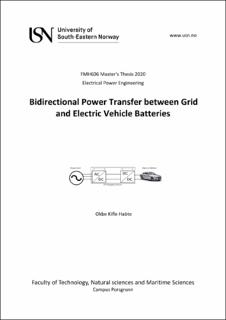Bidirectional Power Transfer between Grid and Electric Vehicle Batteries
Master thesis
Permanent lenke
https://hdl.handle.net/11250/2688594Utgivelsesdato
2020Metadata
Vis full innførselSamlinger
Sammendrag
In the last decades, the significant growth of electric vehicle (EV) is promising an alternative to solve
the concern about fossil fuel and global warming. However, as the number of EVs increasing
significantly, it can cause overload in the existing distribution network of the power system. The vehicleto-grid (V2G) technology is recognized as the best alternative to mitigate the stress in the electric grid
by providing ancillary service and power balancing in the power system. The tasks covered in this thesis
are:
Different effective ways of EV charging are reviewed, and their advantage and disadvantages are
addressed. A literature review of common bidirectional AC-DC and DC-DC converters are carried out.
Several converter topologies can be used to implement the bidirectional EV chargers. It is found that
the two-level three-phase AC-DC converter and either half-bridge buck/boost for a non-isolated
converter or a dual active bridge for an isolated converter in DC-DC converter are leading topologies.
For safe and reliable power transfer between EV and the grid bidirectionally, the available bidirectional
charging standard is investigated. Right now, the only bidirectional charger accepted as standard is the
CHAdeMO with DC charging. Finally, a two-stage bidirectional EV charger with and without galvanic
isolation is developed and simulated in MATLAB/Simulink. The first stage is a three-phase AC-DC
converter, and the second stage is modeled with both half-bridge non-isolated DC-DC converter and
dual active bridge isolated DC-DC converter. All the converters transfer power bidirectionally. The
simulation results showed that the two-way power transfer with the proposed bidirectional EV charging
station models is feasible.
